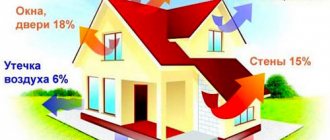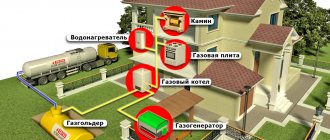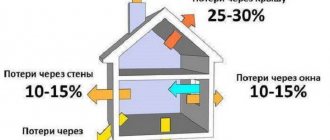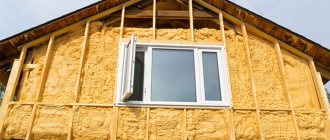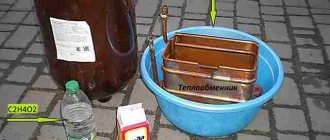Factors influencing gas consumption
The volume of fuel consumption depends on the following parameters:
- Heat loss through the enclosing structures of a private house: external walls, floor and roof. This value determines the required performance of the heating system, and therefore the amount of gas that the boiler consumes per unit of time.
- Fuel calorie content. Depends on its composition and quality. In the presence of nitrogen or water vapor impurities, the flow rate increases.
- Boiler efficiency. Shows what proportion of the received thermal energy is used for its intended purpose. The higher this parameter, the less fuel the boiler will consume at the same heating output. For the most economical models this figure is 98-99%.
- Rated power. The heating device significantly loses efficiency if it operates at half load. For example, the amount of heat loss is 10 kW. The heating system needs to heat the building at the same intensity. A boiler with a capacity of 10 kW will have less gas consumption than an analogue with a capacity of 24 kW.
- Heat generator functionality. A double-circuit boiler that provides space heating and hot water supply will, for obvious reasons, turn out to be more voracious than an analogue that only works to heat the house.
The amount of heat loss is influenced by such characteristics as:
- area of enclosing structures, i.e. house dimensions;
- the materials from which they are constructed, or rather, their thermal conductivity;
- outside temperature;
- level of insolation (sun illumination);
- ventilation of the construction site;
- ventilation performance: the higher the air exchange rate, the more heat is lost through the hood.
The boiler efficiency is affected by:
- Design. For convection heaters, this parameter is 90-94%, for condensing heaters – 98-99%.
- Chimney type. Coaxial ones help improve operating efficiency. They are equipped with boilers with a closed combustion chamber (turbocharged). The increase in efficiency indicator is due to the heating of the air entering the furnace by flue gases.
- Recuperator material. A boiler with a cast iron heat exchanger consumes more gas than its counterpart with copper filling.
- Burner type. Supercharged (used in turbocharged models) is more efficient than atmospheric.
In addition, the condition of the burner and heat exchanger plays an important role. When the first is clogged with dirt, and the second with soot and scale, the level of gas consumption increases.
How much energy does a home heating system consume?
Heat losses include conditions and factors that lower the temperature in the house. It’s impossible to take into account everything, but let’s highlight a few:
- geographical point;
- heated area;
- if the apartment is heated - where is it located;
- external wall material;
- ventilation;
- heat consumption for additional needs.
The first point relates to the climate zone; the further north, the greater the losses. Location of the house in the area. For example, a house located separately, on a hill, is subject to greater influence of wind loads than one protected by other buildings in a lowland.
The second point is more correctly called the heated volume; raising the ceiling increases the area of the external walls that introduce losses. An exception is that a basement room of the same volume loses significantly less heat than an upper room.
The apartment in the center of the house has losses only through one external wall, the upper corner has two street walls plus a ceiling connected to the attic and roof. The southern rooms receive additional heating from the sun, which cannot be said about the northern location.
Thermal insulation of walls is the most important point in saving heat. Most come into contact with the outside air, even a slight reduction in heat loss can produce results. During construction and design, it is worth thinking about the building material. If the building is built, it is necessary to evaluate the thermal conductivity of the walls and insulate them. The expenses will be recouped by reducing gas consumption.
Heat loss diagram
Ventilation is a weak point. Correctly adjusted and in good working order will provide the necessary oxygen and save generated heat. Some use window and door slits as ventilation, however, this approach is not justified by common sense. Gaps may appear in the wall of a home that has not been renovated.
The last item on the list includes gas stoves and hot water supply. Heating occurs indirectly, through an additional heat exchanger. The higher the DHW consumption, the more gas will be consumed.
After determining the heat loss, the energy for replenishment can be calculated. There are formulas and tables, but they are difficult to understand. You can use the simplified diagram shown in the table:
| External surfaces | Losses, W/m2 |
| wall, wall with window | 100 |
| corner two walls, window | 120 |
| two walls, two windows | 130 |
The losses for external walls and windows are shown; you need to select a line and measure the area of the room. For example, we have a wall with one window, the losses will be 100 W/m2. The length of the room is 4 m, the width is 2.75 m, the product is 11 m2. Multiply by 100 W/m2, we get 1100 W or 1.1 kW. Calculations are carried out in all rooms, the result is summed up.
Methods for calculating fuel consumption
In a simplified version, the formula is used: Qtp = 100 × S, where
Qtp – heat loss in the coldest period of the year, W;
S – area of the house, sq. m.
The expression means that for every square meter the heat loss is 100 W. This value was obtained empirically by analyzing houses that meet the following conditions:
- architecture and window sizes are standard;
- ceiling height – up to 3 m;
- the enclosing structures are insulated so that their thermal resistance corresponds to the values established for the given region (SNiP “Building Climatology”).
If the area of the house is, for example, 150 sq. m, heat loss in the coldest period of the year will be: Qtp = 100 × 150 = 15000 W = 15 kW.
Specific energy intensity of natural gas (methane): Eg = 38 MJ/cub. m.
Hourly fuel consumption is determined by the formula: Rch = (Qtp / Eg) × 3600.
For the example given: RF = (15000 / 38,000,000) × 3600 = 1.42 cu. m.
The last step is to determine the actual flow rate taking into account the boiler efficiency. Let a model be selected for which this indicator is 90%. Then hourly consumption: Rchf = Rch / 0.9 = 1.42 / 0.9 = 1.58 cubic meters. m.
It may seem that it is easier to use the passport values for the fuel consumption of the boiler. For example, the documentation for the Baxi Slim 1.150i 3E 15 kW heater indicates that at rated power it consumes 1.74 cubic meters of gas. m/h. But the boiler is always selected with a margin of 15-20%, so that during the coldest period it does not work at its maximum capacity. So, with a maximum loss of 15 kW, a 17-18 kW device, for example, Protherm Bear 20 PLO, is suitable.
A more complex option involves accurate calculation of heat loss. They are determined for each enclosing structure using the formula: Qтп = (S × Δt × k) / R, where
S – element area, sq. m;
Δt – temperature difference between inside and outside, C;
K – dissipation coefficient;
R – thermal resistance of structures, sq. m × S/S.
The value of k for different elements:
- log house, steel structure: 3.0-4.0;
- wall one brick thick, wooden windows without double-glazed windows, old roof: 2.0-2.9;
- double masonry, new roof, double glazed windows, modern doors: 1.1-1.9;
- insulated construction, double-glazed windows: 0.6-1.0.
Thermal resistance of the element: R = d/c.
Here d is thickness, m;
C – thermal conductivity of the material, W/m × C.
The thermal resistance of a multilayer structure, for example, an insulated wall, is determined by adding R of all components.
The value for a window or door is indicated in the product passport. So, for a two-chamber double-glazed window R = 0.49 sq. m × C/W. To the obtained value of Qtp add 20% for ventilation work.
Why is it important to correctly determine the boiler power?
Proper selection of power allows you not only to save on gas, but also to increase the efficiency of the unit. If the heat output exceeds the actual heat requirements, the boiler will operate inefficiently and its parts will begin to wear out.
When purchasing a low-power device, the owner will have to deal with a burner that switches off frequently and will quickly heat small volumes of water. As a result, condensation will begin to accumulate in the heating system. It will lead to the formation of acids that will “eat through” the inner surface of the chimney and then attack the elements of the heating device.
Often homeowners who do not know how to calculate a gas boiler buy equipment with automatic systems that independently regulate fuel consumption.
At first glance, this is convenient, but if the unit is operating at maximum performance, you may encounter the following problems:
- automation failure;
- reduction in burner efficiency;
- reducing the service life of the heating device;
- failure of individual components and parts.
To avoid troubles, you need to buy a device with proper performance that is suitable for a specific room. If necessary, you can contact Mosoblgaz employees, who will calculate the required equipment parameters and help you choose a model taking into account the area of the house.
How to calculate the consumption of a gas boiler using liquefied gas
They act in the same sequence. Only fuel consumption is calculated not in cubic meters or liters, but in kilograms. Propane and butane (a mixture of these gases is supplied in cylinders) contains 46.8 MJ/kg of thermal energy. This means that with heat loss of 15 kW, the hourly consumption will be:
RF = (15000 / 46,800,000) × 3600 = 1.15 kg.
For a unit with efficiency = 90%, the actual consumption corresponds to: Rff = 1.15 / 0.9 = 1.28 kg/h.
Most modern boilers can be easily converted to use liquefied gas by replacing the burner. But kilowatts are much more expensive than when using a mainline analogue.
What volume of gas needs to be burned to generate 1 kW
Depends on the calorific value of the fuel; the higher the value, the less fuel is needed. Heat is usually measured in J/kg, J/m2, J/l. The task is to determine the calorific value and bring it to the required value. For heating use:
- methane;
- propane;
- butane;
- propane-butane.
Propane, butane, and their mixtures have different purifications and calorie content varies. The volume and weight of gas are very variable. Temperature and pressure greatly affect the performance. This is explained by the large expansion coefficient compared to water, 16 times greater. To compare indicators, the test substance must be under the same conditions (temperature, pressure, product purity).
Fuel calorie content
Another indicator that affects the amount of heat received is the efficiency of the boiler. Depending on the design, the average productivity is determined:
- gas convector 86%;
- open type boiler 88%;
- closed combustion chamber 92%;
- condensing gas boiler 96%.
The figures given are averaged; performance is influenced by many factors, for example, heat exchanger material. May be:
- steel;
- cast iron;
- aluminum;
- copper.
Efficiency may deteriorate, the heat exchanger plates burn and become clogged with soot.
Gas heat exchanger
Is it possible to reduce fuel consumption
The following measures will help reduce gas consumption:
- building insulation;
- choosing an economical boiler model;
- timely maintenance;
- replacing a traditional heating system with a “warm floor”;
- the use of vapor-permeable materials for finishing and thermal insulation of walls;
- use of weather-dependent automation.
Condensing heat generators are the most economical. Some sources even report that their efficiency is beyond the realm of possibility - 110-120%. There is no contradiction to the laws of physics here. It’s just that according to Soviet standards, 100% was not taken as the absolute reserve of thermal energy, but only that part of it that, according to the ideas available at that time, could be absorbed under favorable conditions. Condensing boilers have exceeded this limit, which is why their efficiency exceeded one hundred. If we start from absolute energy intensity, then this figure is 98-99%.
But with a traditional heating system designed for a temperature gradient of 90/80 (supply/return), such a boiler cannot work. It is installed to service the “warm floor”.
The use of this type of heating, even in combination with a traditional convection boiler, in itself helps to reduce losses. The arguments are as follows:
- The temperature difference Δt decreases. The amount of heat transferred by an object to the atmosphere, as shown above, is directly dependent on this parameter.
- The heated air flow does not come into contact with the walls.
Among convection boilers, turbocharged ones with a closed firebox have the highest efficiency.
This is explained by two features:
- an economical forced-air burner was installed instead of an atmospheric one;
- A coaxial chimney is used, due to which the air entering the chamber is preheated by flue gases.
Heater maintenance means:
- cleaning the burner nozzles from dirt;
- descaling the heat exchanger.
Blockages disrupt the operation of the equipment; the gas is not completely oxidized.
Scale, having the properties of a heat insulator, prevents the absorption of energy.
High vapor permeability of walls helps reduce humidity. If you insulate the structure with moisture-insulating foam and cover the inside with vinyl wallpaper, then to maintain a comfortable microclimate you will have to increase the ventilation performance. The consequence of this will be an increase in heat loss.
It is recommended to build walls from gas silicate blocks and fence them with mineral wool and cover them with vapor-permeable plaster or install a suspended ventilated façade.
The disadvantage of simple automation is that it only analyzes the temperature of the coolant. With this approach, in the event of sudden warming, the boiler does not have time to adjust its performance in a timely manner and for some time operates with excessive power. Gas consumption is unreasonably high.
It is slightly reduced if an external thermostat is used that analyzes the room temperature. And the most economical boilers are those with weather-dependent automation. A sensor installed outside will give a signal when it gets warmer and the heater will proactively adjust to the new conditions.
Popular models
Samples of gas boilers that are in high demand are represented by single-circuit models in wall-mounted and floor-mounted versions. Their advantages include compactness and ease of maintenance, while their disadvantages include limited functionality.
Wall models
Wall-mounted products are represented by the Viessmann Vitopend 100-W A1HB003 sample, the line of which includes three models with stated powers of 24, 30 and 34 kW. They are manufactured on a single modular platform, which significantly simplifies their on-site installation and warranty service. The advantages of these products include:
- low gas consumption not exceeding 3.5 m3/hour;
- automatic power adjustment depending on the ambient temperature;
- high efficiency, reaching 93%;
- the kit includes a coaxial chimney equipped with frost protection;
- versatility (products can run on liquefied gas).
A relative disadvantage of these models is the lack of a remote control panel.
Floor units
This unit copes well with instability of operating voltage in the electrical network and low level of gas pressure in the system. Thanks to a steel heat exchanger made from 3 mm thick sheets, the GAZ 2500 can operate without breakdowns for almost 20 years. The series presented by the manufacturer from Germany included four models with thermal power from 22 to 42 kW.
Despite the fact that these products are assembled within Russia, they cannot be called cheap. But they have built-in automation, as well as the ability to connect an indirect heating boiler. The advantages of these models include:
- the presence of a reliable steel heat exchanger with increased capacity;
- ability to adjust power in the range from 60 to 100%;
- the permissibility of setting operating modes selected using built-in automation;
- presence of a control panel;
- possibility of reorientation to bottled gas.
The disadvantages of German floor-standing units include their high cost.
Inexpensive units
Relatively inexpensive models of single-circuit gas boilers include products under the brand name Protherm Bear 40 KLOM, designed for a power of at least 35 kW. Units with such indicators are optimally suited for economical homeowners who need to heat living spaces of no more than 250 m2 with warm air. The functionality of this sample is not very large, but everything necessary for its safe operation is optional.
The manufacturer abandoned the built-in electronics, which turned the model into a completely non-volatile device. To put the equipment into operation, it is enough to connect the gas supply to it. Considering the low cost of this sample, no serious shortcomings were found in its operation.
How much gas is used on average per month, day and hour
Consumption per day is determined by the formula: Рsut = Рчф × 24.
In the example described above, the daily consumption will be 1.58 × 24 = 37.92 cubic meters. m.
You can go another way. A properly selected boiler operates at a rated output of 17-18 hours per day. Suppose that with heat losses of 15 kW, it is decided to install a Protherm Bear 20 PLO heater at 17 kW. Its rated gas consumption is 2 cubic meters. m/h. During the day he will spend 34-36 cubic meters. m of fuel, which approximately corresponds to the result obtained above.
The monthly consumption will be: Рм = Рsut × 30 × 0.9, where 30 is the number of days; 0.9 is a reduction factor, taking into account that the lowest possible temperature lasts on average 1-2 weeks.
In the example given, Pm = 37.92 × 30 × 0.9 = 1023.84 cubic meters. m.
Consumption for a heating season lasting 7 months: Rsez = Rsut × 30.5 × 7 × 0.6. The last coefficient is used for the reasons that on average the heater operates at 50-70% of the power required during the coldest period of the year.
For the example above: Рсез = 37.92 × 30.5 × 7 × 0.6 = 4857.6 cu. m.
Conclusions and useful video on the topic
Video instruction: how to calculate heat loss at home and boiler power using the Valtec program.
Competent calculation of heat loss and power of a gas boiler using formulas or software methods allows you to determine with high accuracy the necessary equipment parameters, which makes it possible to eliminate unreasonable fuel costs.
Please write comments in the block form below. Tell us how you calculated heat losses before purchasing heating equipment for your own dacha or country house. Ask questions, share information and photographs on the topic.
Calculation of heat load by room volume
When the distance between the floors and the ceiling reaches 3 m or more, the previous calculation option cannot be used - the result will be incorrect. In such cases, the heating load is usually calculated according to specific aggregated indicators of heat consumption per 1 m³ of room volume.
The formula and calculation algorithm remain the same, only the area parameter S changes to volume – V:
Accordingly, another indicator of specific consumption q is adopted, related to the cubic capacity of each room:
- room inside the building or with one external wall and window – 35 W/m³;
- corner room with one window – 40 W/m³;
- the same, with two light openings - 45 W/m³.
Now, as an example, let’s determine the heating load of our cottage, taking the ceiling height to be 3 m:
Q = (47.25 x 45 + 63 x 40 + 15 x 35 + 21 x 35 + 18 x 35 + 47.25 x 45 + 63 x 40) x 1 = 11182 W ≈ 11.2 kW.
It is noticeable that the required thermal power of the heating system has increased by 200 W compared to the previous calculation. If we take the height of the rooms to be 2.7-2.8 m and calculate the energy costs per cubic capacity, then the figures will be approximately the same. That is, the method is quite applicable for an aggregated calculation of heat loss in rooms of any height.




